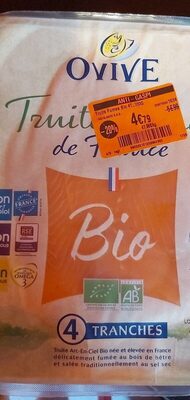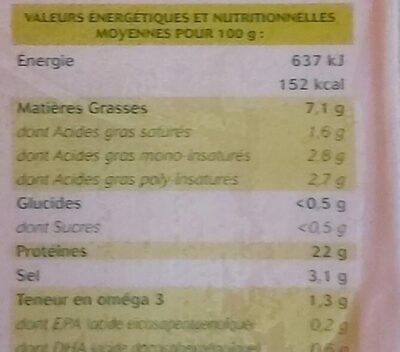Help us make food transparency the norm!
As a non-profit organization, we depend on your donations to continue informing consumers around the world about what they eat.
The food revolution starts with you!
Truite - Ovive - 100 g
Truite - Ovive - 100 g
Barcode: 3392780001634 (EAN / EAN-13)
Quantity: 100 g
Packaging: fr:Barquette-plastique, fr:Etui-carton, fr:Film en plastique
Brands: Ovive
Categories: Seafood, Fishes and their products, Fishes, Fatty fishes, Smoked fishes, Trouts, Farmed trouts, Farmed rainbow trout, Smoked farmed trout, Smoked trouts
Labels, certifications, awards:
Organic, EU Organic, No GMOs, FR-BIO-01, AB Agriculture Biologique, Agri-Confiance, fr:Origine France

Origin of ingredients: France
Manufacturing or processing places: France
Traceability code: EMB 40288B - Sarbazan (Landes, France), FR 40.288.002 CE - Sarbazan (Landes, France)
Stores: Magasins U, Leclerc
Countries where sold: France
Matching with your preferences
Health
Ingredients
-
3 ingredients
: Truite Arc-en-Ciel (Oncorhynchus mykiss) 97%, sel 3%Allergens: FishTraces: Fish
Food processing
-
Processed foods
Elements that indicate the product is in the 3 - Processed foods group:
- Ingredient: Salt
Food products are classified into 4 groups according to their degree of processing:
- Unprocessed or minimally processed foods
- Processed culinary ingredients
- Processed foods
- Ultra processed foods
The determination of the group is based on the category of the product and on the ingredients it contains.
Ingredients analysis
-
Palm oil free
No ingredients containing palm oil detected
-
Non-vegan
Non-vegan ingredients: Rainbow trout, Rainbow trout
-
Non-vegetarian
Non-vegetarian ingredients: Rainbow trout, Rainbow trout
-
Details of the analysis of the ingredients
: Truite Arc-en-Ciel 97% (Oncorhynchus mykiss), sel 3%- Truite Arc-en-Ciel -> en:rainbow-trout - vegan: no - vegetarian: no - ciqual_proxy_food_code: 26140 - percent_min: 97 - percent: 97 - percent_max: 97
- Oncorhynchus mykiss -> en:rainbow-trout - vegan: no - vegetarian: no - ciqual_proxy_food_code: 26140 - percent_min: 97 - percent_max: 97
- sel -> en:salt - vegan: yes - vegetarian: yes - ciqual_food_code: 11058 - percent_min: 3 - percent: 3 - percent_max: 3
- Truite Arc-en-Ciel -> en:rainbow-trout - vegan: no - vegetarian: no - ciqual_proxy_food_code: 26140 - percent_min: 97 - percent: 97 - percent_max: 97
Nutrition
-
Poor nutritional quality
⚠ ️Warning: the amount of fruits, vegetables and nuts is not specified on the label, it was estimated from the list of ingredients: 0This product is not considered a beverage for the calculation of the Nutri-Score.
Positive points: 0
- Proteins: 5 / 5 (value: 22, rounded value: 22)
- Fiber: 0 / 5 (value: 0, rounded value: 0)
- Fruits, vegetables, nuts, and colza/walnut/olive oils: 0 / 5 (value: 0, rounded value: 0)
Negative points: 12
- Energy: 1 / 10 (value: 637, rounded value: 637)
- Sugars: 0 / 10 (value: 0.5, rounded value: 0.5)
- Saturated fat: 1 / 10 (value: 1.69, rounded value: 1.7)
- Sodium: 10 / 10 (value: 1240, rounded value: 1240)
The points for proteins are not counted because the negative points are greater or equal to 11.
Nutritional score: (12 - 0)
Nutri-Score:
-
Nutrient levels
-
Fat in moderate quantity (7.19%)
What you need to know- A high consumption of fat, especially saturated fats, can raise cholesterol, which increases the risk of heart diseases.
Recommendation: Limit the consumption of fat and saturated fat- Choose products with lower fat and saturated fat content.
-
Saturated fat in moderate quantity (1.69%)
What you need to know- A high consumption of fat, especially saturated fats, can raise cholesterol, which increases the risk of heart diseases.
Recommendation: Limit the consumption of fat and saturated fat- Choose products with lower fat and saturated fat content.
-
Sugars in low quantity (0.5%)
What you need to know- A high consumption of sugar can cause weight gain and tooth decay. It also augments the risk of type 2 diabetes and cardio-vascular diseases.
Recommendation: Limit the consumption of sugar and sugary drinks- Sugary drinks (such as sodas, fruit beverages, and fruit juices and nectars) should be limited as much as possible (no more than 1 glass a day).
- Choose products with lower sugar content and reduce the consumption of products with added sugars.
-
Salt in high quantity (3.1%)
What you need to know- A high consumption of salt (or sodium) can cause raised blood pressure, which can increase the risk of heart disease and stroke.
- Many people who have high blood pressure do not know it, as there are often no symptoms.
- Most people consume too much salt (on average 9 to 12 grams per day), around twice the recommended maximum level of intake.
Recommendation: Limit the consumption of salt and salted food- Reduce the quantity of salt used when cooking, and don't salt again at the table.
- Limit the consumption of salty snacks and choose products with lower salt content.
-
-
Nutrition facts
Nutrition facts As sold
for 100 g / 100 mlCompared to: Farmed rainbow trout Energy 637 kj
(152 kcal)+9% Fat 7.19 g +19% Saturated fat 1.69 g +24% Monounsaturated fat 2.8 g Polyunsaturated fat 2.7 g Omega 3 fat 1,300 mg Eicosapentaenoic acid 0.2 g Docosahexaenoic acid 0.6 g Carbohydrates 0.5 g -52% Sugars 0.5 g +85% Fiber 0 g Proteins 22 g +17% Salt 3.1 g +266% Fruits‚ vegetables‚ nuts and rapeseed‚ walnut and olive oils (estimate from ingredients list analysis) 0 %
Environment
-
Eco-Score D - High environmental impact
⚠ ️Select a country in order to include the full impact of transportation.The Eco-Score is an experimental score that summarizes the environmental impacts of food products.→ The Eco-Score was initially developped for France and it is being extended to other European countries. The Eco-Score formula is subject to change as it is regularly improved to make it more precise and better suited to each country.Life cycle analysis
-
Average impact of products of the same category: E (Score: 19/100)
Category: Trout, farmed, smoked
Category: Trout, farmed, smoked
- PEF environmental score: 1.56 (the lower the score, the lower the impact)
- including impact on climate change: 7.05 kg CO2 eq/kg of product
Stage Impact Agriculture
90.3 %Processing
4.2 %Packaging
0.9 %Transportation
2.7 %Distribution
1.6 %Consumption
0.2 %
Bonuses and maluses
-
Labels with high environmental benefits
Bonus: +15
-
AB Agriculture Biologique
Organic agriculture contributes to preserve biodiversity, climate, water quality and soil fertility.
Organic food is food produced by methods complying with the standards of organic farming and features practices that cycle resources, promote ecological balance, and conserve biodiversity.
-
EU Organic
Organic agriculture contributes to preserve biodiversity, climate, water quality and soil fertility.
Organic food is food produced by methods complying with the standards of organic farming and features practices that cycle resources, promote ecological balance, and conserve biodiversity.
-
-
Origins of ingredients with a medium impact
Bonus: +4
Environmental policy: +4
Transportation: 0
Origin of the product and/or its ingredients % of ingredients Impact France 100 %Medium
-
Packaging with a medium impact
Malus: -12
Shape Material Recycling Impact Tray Plastic High Film Plastic High Sleeve Cardboard Low
Eco-Score for this product
-
Impact for this product: D (Score: 26/100)
Product: Truite - Ovive - 100 g
Life cycle analysis score: 19
Sum of bonuses and maluses: +7
Final score: 26/100
-
Carbon footprint
-
Equal to driving 3.7 km in a petrol car
705 g CO² per 100g of product
The carbon emission figure comes from ADEME's Agribalyse database, for the category: Trout, farmed, smoked (Source: ADEME Agribalyse Database)
Stage Impact Agriculture
84.7 %Processing
3.5 %Packaging
2.6 %Transportation
7.7 %Distribution
1.4 %Consumption
0.1 %
Packaging
-
Packaging with a medium impact
-
Packaging parts
Tray (Plastic)
Film (Plastic)
Sleeve (Cardboard)
-
Packaging materials
Material % Packaging weight Packaging weight per 100 g of product Paper or cardboard Plastic Total
-
Transportation
-
Origins of ingredients
Origins of ingredients with a medium impact
Origin of the product and/or its ingredients % of ingredients Impact France 100 %Medium
Labels
-
AB Agriculture Biologique
Organic agriculture contributes to preserve biodiversity, climate, water quality and soil fertility.
Organic food is food produced by methods complying with the standards of organic farming and features practices that cycle resources, promote ecological balance, and conserve biodiversity.
-
EU Organic
Organic agriculture contributes to preserve biodiversity, climate, water quality and soil fertility.
Organic food is food produced by methods complying with the standards of organic farming and features practices that cycle resources, promote ecological balance, and conserve biodiversity.
Report a problem
-
Incomplete or incorrect information?
Category, labels, ingredients, allergens, nutritional information, photos etc.
If the information does not match the information on the packaging, please complete or correct it. Open Food Facts is a collaborative database, and every contribution is useful for all.
Data sources
Product added on by niako
Last edit of product page on by foodvisor.
Product page also edited by date-limite-app, kiliweb, magasins-u, norbert45fr, off.7713ac3d-d4fd-44fd-93f6-f7429965d8a3, openfoodfacts-contributors, packbot, quechoisir, rdg, roboto-app, tacite, versgui, yuka.SC9vZkxvc2gvOTlUa3ZBRTl6V0YzTk1vNG9HYmZIMmJjcnRCSVE9PQ, yuka.U0pnZktMUlF2OWtrbWZOaDFEblN3ZFoxd3IyNVp6NnhMT0ZMSUE9PQ, yuka.VEs4UkFmb04rOEVKcGNRbi9UM0o4TmxXL2NhUURFYnBOL1EwSVE9PQ, yuka.Vm9FR09wZ0R0Tk0wc01RN3J3M0w4Tk40NFpPR1hHNnRJdU1qSVE9PQ, yuka.sY2b0xO6T85zoF3NwEKvlk9Kf8fajG_FBiTjgGjVnO-hAqXnZdV88rD8aqo, yuka.sY2b0xO6T85zoF3NwEKvlnBHTvvE-S6VKTHQixKu9uWPLKzBSO9y4a3jAas.















